calyptura.com
Jon and Anne's birding travels
Paraguay
"An island surrounded by land"
Posted 10th June 2012
So wrote Roa Bastos, one of Paraguay's most famous writers. This may be a harsh assessment, but probably an accurate one, of this landlocked yet isolated and frankly quirky country. Though barely visited by tourists, and even less so by birdwatchers, we had read about Paraguay’s recent “colourful” history and were very intrigued by this and its landscapes. In combination with the chance to look for a handful of new birds that we had missed elsewhere (Paraguay has only one endemic bird, of questionable taxonomic validity), plus one very rare one, the White-winged Nightjar, this led us to take a bit of a detour in our travels to spend some time in this relatively small country near the middle of the continent.
We started our three weeks in Paraguay entering from the south at Encarnacion, and after a couple of days made it to the capital Asuncion. We received an exceptionally friendly welcome at the office of Guyra Paraguay, the BirdLife International partner in the country. They arranged for us to be interviewed the following Monday by the largest newspaper in the country, which gave us a rare excuse to stay in a city for a weekend and take a look around. Then we spent about a week birding in the Chaco (the western half of the country), before searching for the extremely localised nightjar at Reserva Natural Laguna Blanca back in the east. After an overnight at Parque Nacional Cerro Cora and another near Pedro Juan Caballero, we crossed back into Brazil with the Pantanal in our sights.
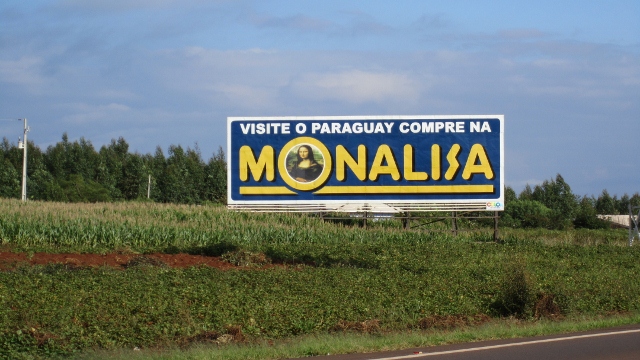
"Visit Paraguay and buy the Mona Lisa." These billboards line the highway west through Brazil that goes to Paraguay, which we took to the Iguacu Falls. You have to love a country whose international tourism advertising campaign emphasises the fact that you can buy anything there, probably fake, but perhaps even real, albeit smuggled and/or stolen. Paraguay is well-known as one of the World's greatest smuggling hubs, which was the primary business of the military under the dictatorship of Stroessner. For example, Paraguay imports more whisky per capita than any country in the World, very little of which is drunk there (it almost all finds its way illegally into neighbouring countries). Indeed the border cities are notoriously lawless in general. It is easy to buy heavy duty military hardware in regular shops in some of the border towns, if you have the cash. So "relaxed" are Paraguay's borders that various terrorist organisations (Hezbollah, among others) are known to have operations based around Cuidad del Este, where the Paraguay, Brasil and Argentina borders meet near Iguacu.
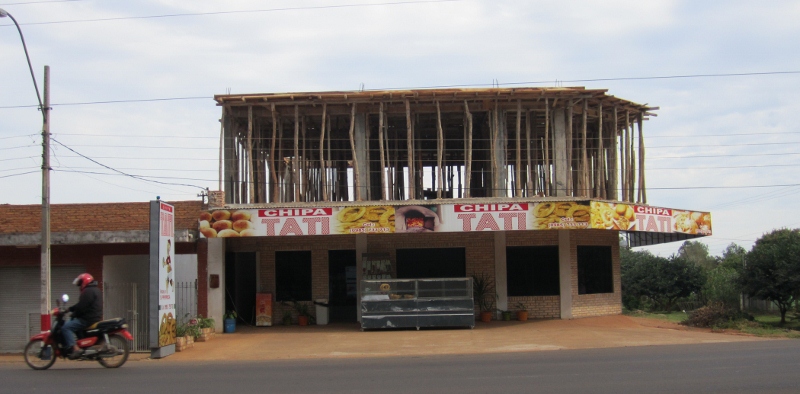
Chipa is a cheesy corn bread typical of eastern Paraguay and adjacent northernmost Argentina. The tiny peublo of Coronel Bogado is the chipa capital of Paraguay, and Chipa Tati is considered the best in town. There are at least six chipa bakeries along its single main street. Apparently business at Chipa Tati is good enough to add another floor. (Needless to say, the chipa was superb, still warm from the oven.)
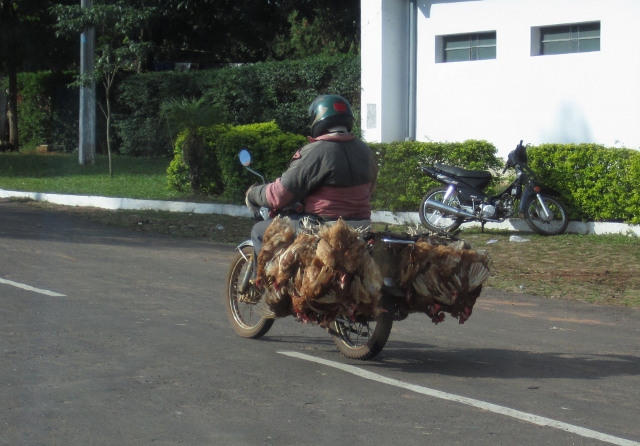
Chicken delivery man on the streets of Asuncion. It doesn’t get much fresher than this.
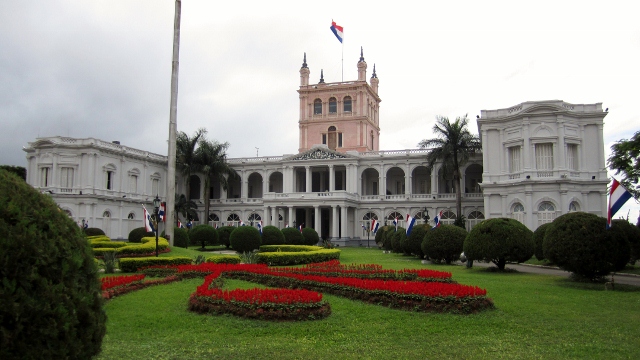
The Presidential Palace was certainly the most heavily guarded building we encountered, with soldiers stationed at regular intervals and ready to blow their whistles at us when we each accidentally strayed into unauthorized territory. The palace was started in the mid-1800s but took many years to build because its construction partly overlapped with the War of the Triple Alliance (Paraguay was opposed by Argentina, Brazil, and Uruguay) when adult male labor was very difficult to come by. Per capita probably the bloodiest war in human history, by its end a national population of 1.3 million had been reduced to just over 220,000, of which fewer than 30,000 were men. There was so little left of the country that the thoroughly victorious Allies all took a piece of territory and left. The war reparations claim of Argentina was adjudicated by then U. S. President Rutherford Hayes. Although he is little more than footnote in US history, when Hayes ruled in favour of Paraguay, he became a national hero there, and to this day has innumerable streets, a city and an entire department (province) named after him.
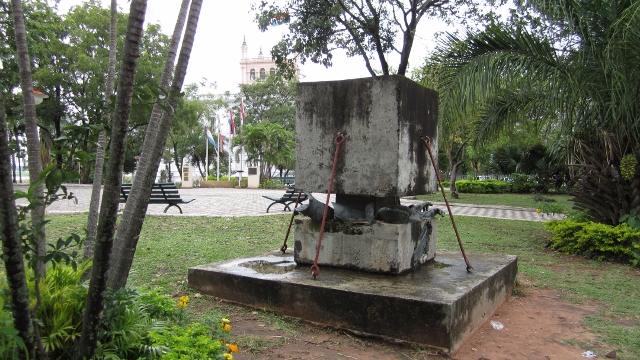
This may be indicative of how Paraguay deals with its past. After his removal as military dictator in a coup d’etat in 1989, the statue of Alfredo Stroessner in the plaza next to the presidential palace was encased in a concrete block rather than being removed. Now it sits as an arguably appropriate memorial to a peculiar era. Unlikely things happen in odd countries, and on our first day in Asuncion we had the pleasure of meeting Stroessner’s grandson (also Alfredo). Businessman and member of the Paraguayan senate, he is a thoroughly nice chap, and a member of the board of directors of Guyra Paraguay, the Birdlife International partner, whose office we happened to be visiting the day of a board meeting. He was very interested in our travels and keen to see our vehicle, so we gave him a full tour. Alfredo commented that it is his dream to travel as we are; this is something we often hear, but not from someone in his position.
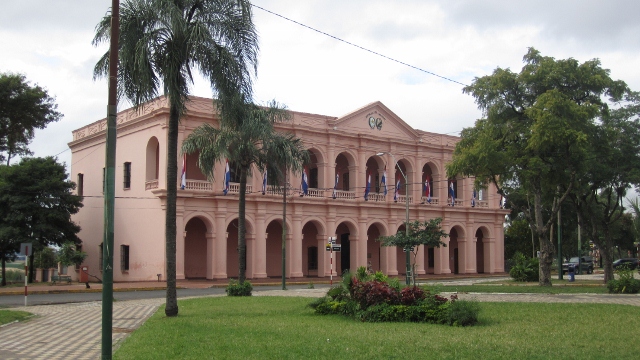
The old pink Palacio Legislativo has functionally been replaced by a massive garish modern building in an adjacent block which just fails to completely ruin the lovely little neighbourhood of colonial-style plazas and government buildings on the Asuncion riverfront. There was evidence of relatively recent patching on the façade which we think was done to cover damage left from tank fire during a failed coup d’etat in 2000. Apparently, a small tank was driven into the city from the west and opened fire on the building, but the anticipated support never materialized and the coup attempt fizzled.
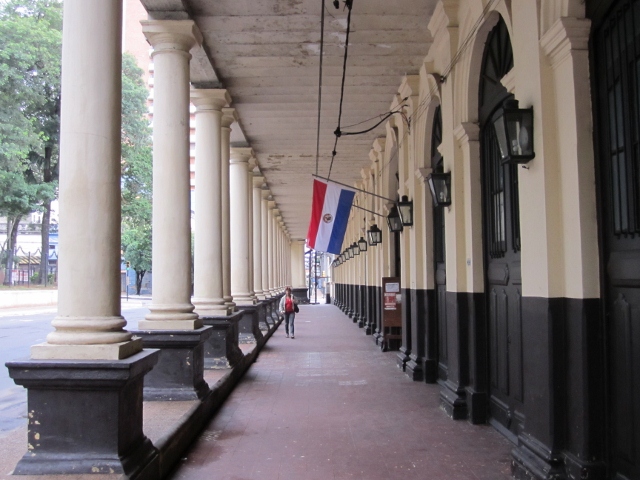
The Railway Station Museum was one of the most impressive buildings in downtown Asuncion. The adjacent central railway station was marked on our map as “Railway abandoned – pending future funding”. This seemed more than a little optimistic however, as more than a decade has passed since the last train ran and railway lines have been paved over in many places where they run along city streets.
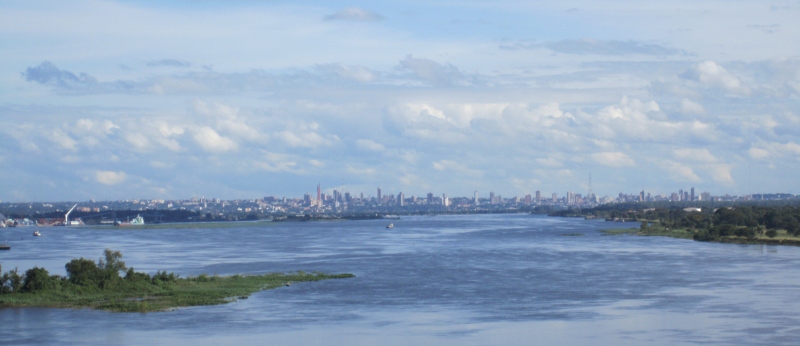
As you cross the mighty Paraguay River (with Asuncion along the shore in the distance) you enter a very different part of the county, first traveling through expansive palm savannah swamps then entering the humid chaco and eventually the dry chaco in the far west. Although we had visited the dry chaco of adjacent parts of both Bolivia and Argentina, we decided to make the long journey to the Paraguayan chaco in search of a couple of species that had eluded us and because we had read a great deal about the region and wanted to see it for ourselves. We were not disappointed.
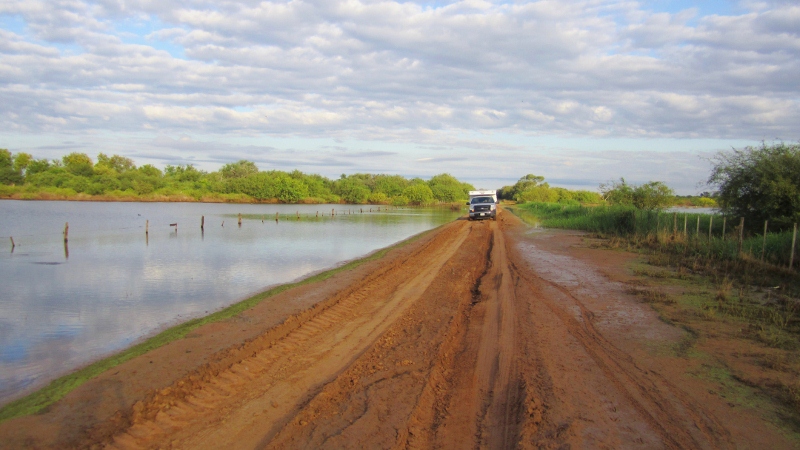
Surprisingly, there had been a lot of rain over the whole chaco region in the recent past. Victor, a cattleman Jon chatted with, said they had been experiencing a drought prior to receiving five years worth of rain in the previous three months! As a result, this normally very arid region was lush with fresh green vegetation and dotted with ponds and lakes where typically there are none. Although access to some sites we hoped to visit was thwarted by impassable muddy roads we did as much exploring as we could given the conditions. It did however bring us into closer contact with wetland birds, many of which could be seen very easily right by the roadside.
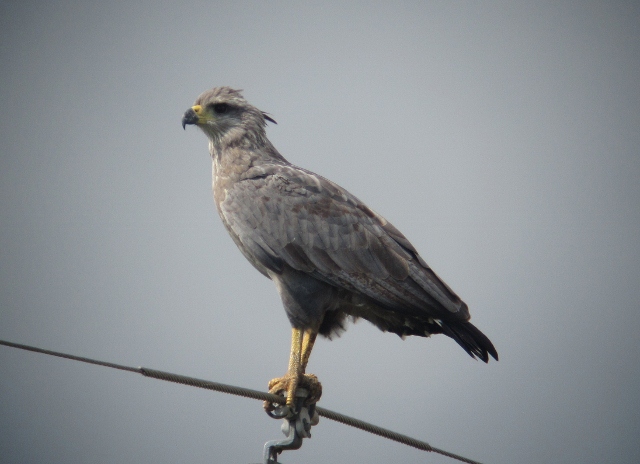
Adult Crowned Eagle, 2nd June 2012, KM530 Transchaco highway, department Boqueron, western Paraguay. The transition of open habitats along the 700+km of the Transchaco highway makes for a great diversity of birds of prey. Following an excellent suggestion from our friend Rob who works for BirdLife in Asuncion, we did raptor surveys along the drive, which kept us alert and may contribute some interesting data given the changes the region is experiencing. We recorded 25 species of raptor, of which Crowned Eagle was the most impressive (we were fortunate to find two, some 300km apart). This threatened species is probably easier to see in western Paraguay than anywhere else.
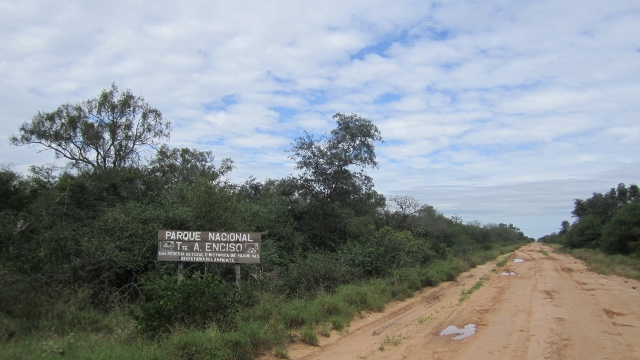
We made it as far west as Parque Nacional Teniente Enciso, some 700km from Asuncion. This and two much larger parks farther north will hopefully preserve some of the rapidly disappearing chaco habitat. The rate of removal of this unique thorn forest has increased exponentially in recent years, with 10% of its extent - over one million hectares - cut since 2006 (Guyra Paraguay data, from satellite imagery). What may have been one of the World’s last truly wild places not too long ago is being converted to cattle ranches, soybean fields and other agribusiness interests, largely by Brazilian, American, and European investors. Other than the sign, we could have taken this photo in outback Australia, as the thorn scrub habitat and wide desert tracks were reminiscent of that area we know so well. One evening Jon was fortunate to have a great view of a Puma (Mountain Lion) crossing the track.
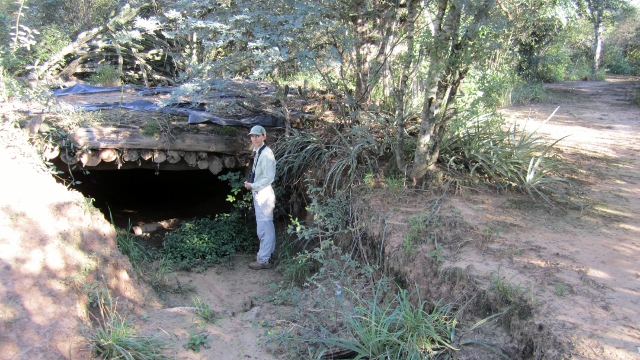
An interesting aspect of our western exploration was seeing some trails, trenches, bunkers, and other remnants of the early 1930s Chaco War between Paraguay and Bolivia. With the World Wars either side of it, this conflict barely features in the history books, but it was one of Latin America’s bloodiest, although the majority of casualties were from hunger and thirst, rather than enemy fire. This photo of a bunker and trench is from Fortin Toledo. It is impossible to imagine soldiers enduring these conditions in the near-impenetrable chaco scrub, with sweltering temperatures, little food, and an often fatal scarcity of water. Although the Bolivians won the short battle at Toledo, predictably all this nonsense ended in a truce with no significant change in borders. Paraguay claims this as something of a victory, given Bolivia was the aggressor, having (mistakenly) assumed it could take much of the Paraguayan chaco relatively easily.
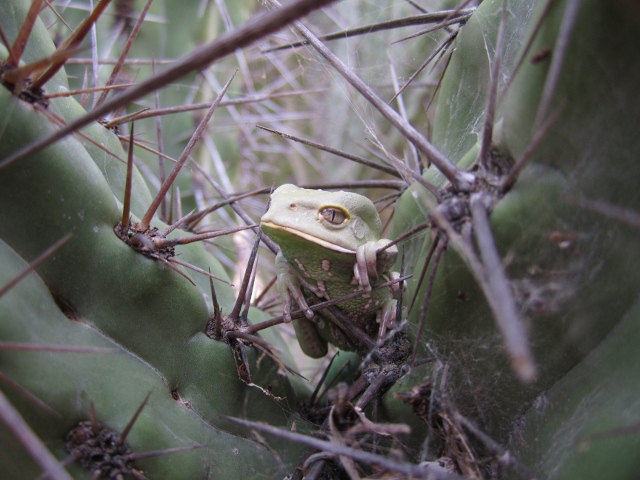
As if the chaco wasn’t curious enough, the frogs live in the cacti. We have been saving up many non-bird animal photos for a blog feature later, but we had to put these two in now. We are still working to identify the two different species (above and below) that we found dwelling in very different ways among the cacti at Fortin Toledo.

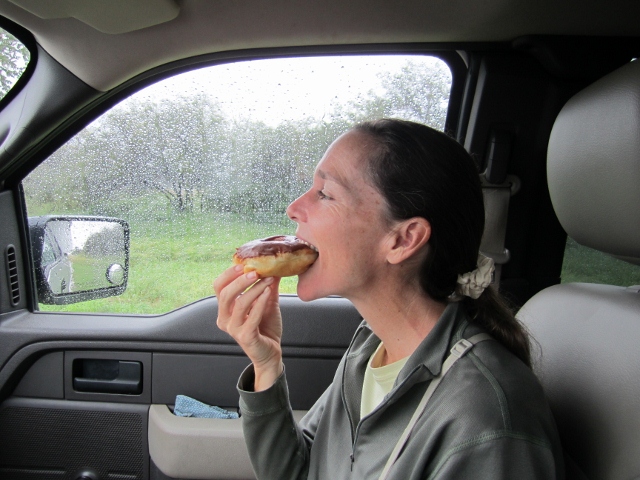
Our first doughnuts since Peru, a year ago. Being something of baked goods connoisseurs, we tend to be rather picky, but these were excellent. The central chaco around Filadelfia was first developed for agriculture by immigrant Mennonite Anabaptists, originally from Germany, via Ukraine and Canada, in the late 1920s. With Jon having some firsthand experience of the Germanic facility for baking, we suspected we might be able to find some goodies in the region, and our quest was thoroughly successful at the Loma Plata bakery. Many folks we encountered in this corner of Paraguay were tall and fair, and were markedly less comfortable speaking Spanish than Jon, Plattdeutsch (“Low” German) being their native tongue. Those now living in this region are not ultra-traditional Mennonites (as we had encountered in Belize), but although they embrace the use of modern technologies, they still farm in a cooperative. They were highly regarded by the Paraguayans we talked to, for their energy and persistence in having carved out productive agricultural land from such inhospitable surroundings. They were highly regarded by us for making the finest doughnuts we had found in southern South America.
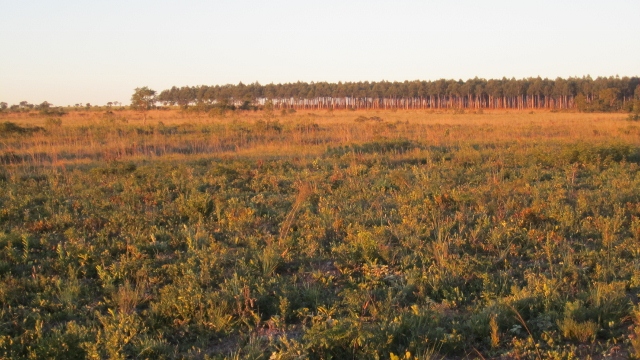
Habitat of White-winged Nightjar near Reserva Natural Laguna Blanca, taken just before sunset. This is where a very small non-profit, Para La Tierra, is working, in part to try to study and conserve a population of the nightjar. Known only from four sites globally, and only three of those reliably (two in Paraguay), this species is extremely poorly known and listed as Endangered, with an estimated World population under 2500 individuals. The scrubby campo habitat above is home to one of these populations, of as yet unknown size. In the distance, one of the key threats to the species is apparent, a plantation of eucalyptus trees.

Jon found these two nightjars, a male (above) and a female (below). They are small and compact, and frankly rather cute, with the adorably helpful habit of perching on termite mounds, which makes them easy to find after dusk by torchlight, if you know where and how. Indeed the presence of mounds may be a critical aspect of the habitat needed by the nightjars. The male has a longer grey-white tail and black outer wing (the white inner wing from which it gets its name is largely obscured when perched) and the female is browner and less boldly patterned. We saw at least three in total, and Jon estimates that there may be a population of at least 100 at the Laguna Blanca site. We were impressed by the commitment of the Para La Tierra project, and ended up staying a couple of additional days, doing some volunteer work that ranged from varnishing tables for their tiny new museum/lab, to providing our advice on grant applications for future biological research on the nightjars. See their website to learn more about the great work they are doing: www.paralatierra.org
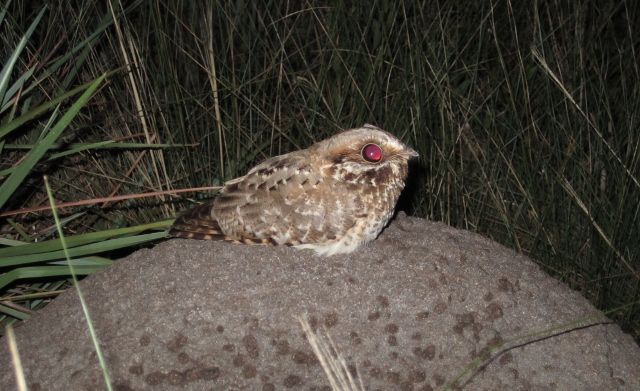
Image copyright notice
All images on this website are subject to copyright (© Jon King, unless otherwise stated). If you wish to use them, whether commercially or non-commercially, please inform Jon by email.
Images appearing on calyptura.com can be used free of charge by individuals and non-profit organisations for strictly non-commercial use. They can be linked or copied to other websites, or downloaded to personal computers. The only exception to this policy concerns non-commercial use of images by any individual or organisation promoting trade in captive birds, or any other activity deemed detrimental to wild birds and their habitats. This use is not permitted.
All other commercial use of images is unauthorized. If you would like to use images for any commercial purpose (i.e. publication in books, magazines, commercial websites, advertisements etc.), or if you are seeking higher resolution scans, slide duplicates or prints, please contact Jon by email.
Jon and Anne's birding travels